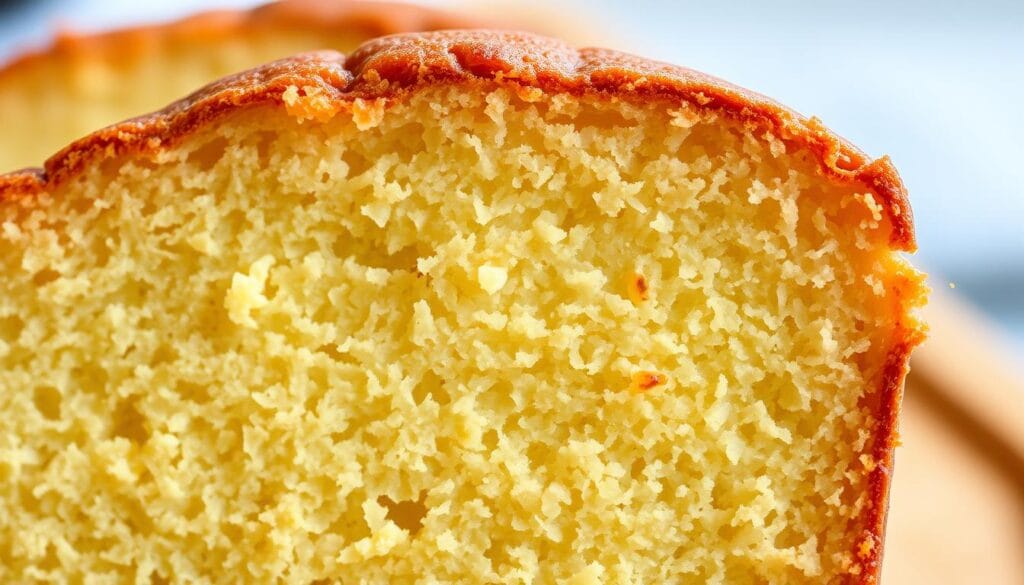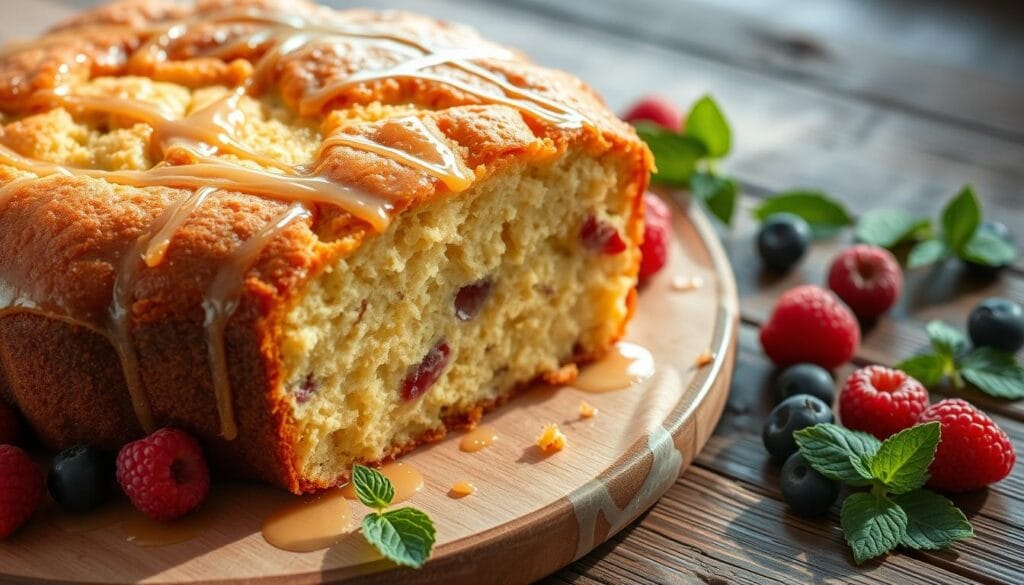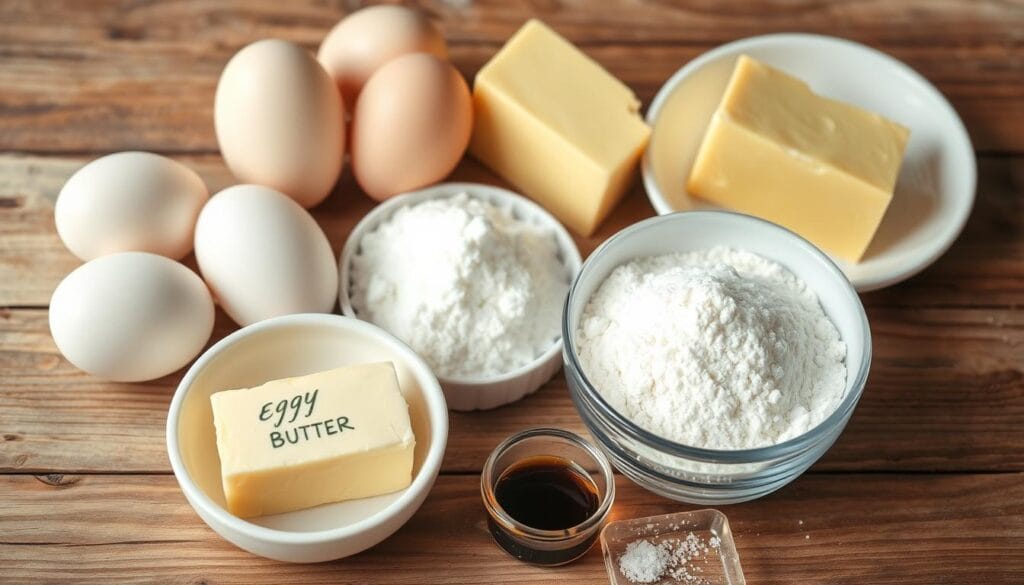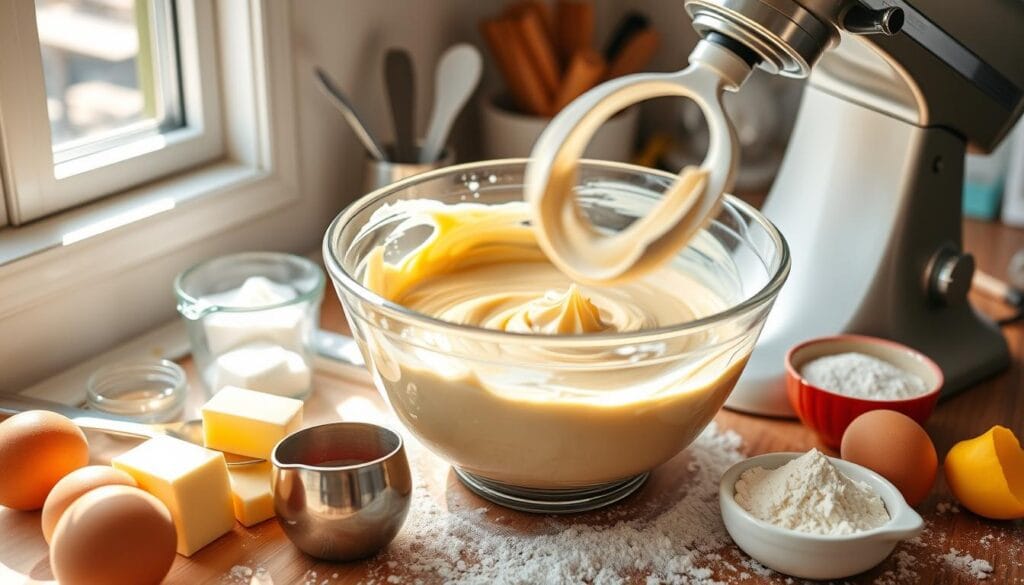I love baking pound cakes because they’re moist and full of flavor. Pound cakes have a rich history and are very versatile. They can be vanilla, chocolate, or lemon, and they all need to be moist.
In this article, we’ll share tips on keeping pound cakes moist. We’ll talk about the right ingredients and how to mix them. You’ll learn how to make sure your pound cakes are always soft and delicious.
Understanding the Fundamentals of Pound Cake
Pound cake is a favorite dessert known for its rich taste and soft texture. The old recipe used a pound each of flour, sugar, eggs, and butter. This made a big, rich cake. Today, recipes have changed, but the key to a moist cake is the same.
Traditional Recipe Origins
The pound cake started in 18th-century Europe. It was a simple but rich treat. The mix of flour, sugar, eggs, and butter made a dense, tasty cake.
The Science Behind Moisture Content
The secret to a moist pound cake is in the ingredients and how they’re mixed. The butter and eggs’ temperature and mixing methods affect the cake’s moisture. Knowing this science helps bakers make cakes that are always moist and tasty.
Basic Ingredient Ratios
The old 1:1:1:1 ratio of flour, sugar, eggs, and butter is still key. Pound cake recipes now use more butter and eggs for a richer taste. Adding baking powder also makes the cake dense but tender.
| Ingredient | Traditional Ratio | Modern Ratio |
|---|---|---|
| Flour | 1 pound | 2 cups (250g) |
| Sugar | 1 pound | 1 1/2 cups (300g) |
| Eggs | 1 pound (about 8-9 eggs) | 6 large eggs |
| Butter | 1 pound | 1 cup (226g) |
| Leavening | None | 1 teaspoon baking powder |
Knowing about pound cake’s history, moisture, and ingredients is key for bakers. It helps make the perfect, moist pound cake every time.

How Do You Keep Pound Cake Moist
To make a moist and tender pound cake, you need to balance ingredients and techniques. Here are some key tips to avoid a dry or dense cake:
- Use room temperature ingredients, especially butter and eggs. Cold ingredients can make creaming and mixing hard.
- Cream the butter and sugar until light and fluffy, about 5-7 minutes. This adds air for a soft texture.
- Add eggs one at a time, mixing just until they’re fully incorporated. Too much mixing can make the cake tough.
- Alternate adding dry and wet ingredients, starting and ending with dry. This keeps the texture delicate.
- Avoid mixing too much after adding flour. Too much mixing can make the cake dense and dry.
- Bake at the right temperature, around 325°F, and don’t overbake. Check with a toothpick for doneness.
- Let the cake cool in the pan before removing it. This helps keep it moist.
- Try using simple syrup or other methods to add moisture if your cake is still a bit dry.
By following these tips, your pound cake will be moist, tender, and delicious every time.
| Ingredient | Amount |
|---|---|
| Unsalted Butter | 1 cup |
| Large Eggs | 6 |
| Sugar | 3 cups |
| Baking Temperature | 325°F |
| Baking Time | 65-70 minutes |

Essential Ingredients for a Moist Pound Cake
Making a moist pound cake starts with the right ingredients. You need good butter, eggs, and flour. Each one is key for the cake’s texture and taste.
The Role of Butter and Fats
Butter is the base of a moist pound cake. It adds flavor and softness. Choose unsalted butter for the best taste.
The fat in butter makes the cake tender. Using about 1 cup of butter is important for keeping it moist.
Dairy Components
Dairy like sour cream or full-fat yogurt adds moisture. They make the batter stick together, creating a soft cake. Try different dairy to find your favorite.
Moisture-Adding Elements
Adding things like fruit purees or oils also helps. Applesauce or mashed bananas add moisture and flavor. A little olive oil can also help keep the cake moist.
Choosing the right ingredients makes a moist pound cake. It’s a treat that everyone will love. Try different mixes to find your favorite.
| Ingredient | Quantity | Nutrition Facts (per serving) |
|---|---|---|
| Butter | 1 cup | Calories: 560 kcal, Fat: 28 g, Saturated Fat: 17 g, Cholesterol: 150 mg |
| Sugar | 1 cup | Carbohydrates: 72 g, Sugar: 46 g |
| Eggs | 4 large | Protein: 7 g |
| Flour | 2 cups | Carbohydrates: 72 g, Fiber: 1 g |

Proper Mixing Techniques
To make a moist and tender pound cake, you need to master mixing. The secret is in creaming butter and sugar, adding eggs carefully, and folding in flour gently. Let’s explore the key steps for a delicious pound cake.
- Cream the Butter and Sugar: Start by creaming butter and sugar at medium-high speed for 4-5 minutes. This adds air, making the cake light and fluffy.
- Add Eggs Gradually: Add eggs one at a time, beating well after each. This helps mix the batter smoothly and prevents eggs from curdling.
- Gently Fold in the Flour: After adding eggs, mix in the flour slowly. This avoids a tough cake. Use a spatula to fold in the last bit of flour carefully.
Good mixing is key to avoiding a dry, dense cake. Always scrape the bowl sides and bottom to mix evenly. With these tips, you’ll make a moist and tasty pound cake.
| Ingredient | Amount |
|---|---|
| All-Purpose Flour | 2 cups |
| Unsalted Butter | 1 cup (2 sticks) |
| Eggs | 4 large |
| Vanilla Extract | 2 teaspoons |
| Salt | 1/2 teaspoon |

By using these pound cake baking techniques, you’ll make a moist pound cake recipe that will wow everyone. The trick to avoiding a dry pound cake is in the right mixing and ingredients.
Temperature Control and Timing
Mastering the art of keeping your pound cake moist and delicious starts with temperature control and proper timing. Let’s dive into the key aspects that will ensure your baked creation achieves the perfect texture and moisture level.
Optimal Baking Temperature
Preheat your oven to the correct temperature, typically ranging between 325°F to 350°F for pound cakes. Using an oven thermometer is highly recommended to ensure the temperature is accurate, as oven temperatures can fluctuate. This precise temperature range allows the pound cake to bake evenly, resulting in a moist and tender crumb.
Signs of Perfect Doneness
Keeping a close eye on your pound cake as it bakes is crucial. Insert a toothpick or cake tester into the center of the cake. When it comes out clean or with just a few moist crumbs, your cake is perfectly baked. Avoid the temptation to open the oven door frequently, as this can cause the cake to collapse or become dry.
Cooling Process Guidelines
After your pound cake has finished baking, let it cool in the pan for 20-30 minutes before inverting it onto a wire rack. This gradual cooling process helps the cake maintain its moisture and prevent sticking to the pan. Never allow the cake to cool completely in the pan, as this can lead to excess moisture and an undesirable texture.
By following these temperature control and timing guidelines, you’ll be well on your way to creating a moist and flavorful pound cake that will impress your family and friends. Remember, consistency is key, so use an oven thermometer and stick to the recipe instructions for the best results.
Simple Syrup and Moisture Enhancement Methods
Keeping your pound cake moist is a delicate task. But, there are simple tricks to keep it moist and tasty. One trick is to brush a simple syrup over the cooled cake. To make the syrup, boil equal parts sugar and water until the sugar dissolves. Then, brush the warm syrup over the cake’s surface. This locks in moisture and adds a hint of sweetness.
To make your pound cake even better, add moisture-enhancing ingredients to the batter. Fruit purees like applesauce or mashed bananas add moisture and sweetness. You can also brush the cake with fruit juices or non-alcoholic extracts. This can make a dry cake moist again or add extra flavor.
| Moisture Enhancement Technique | Benefits |
|---|---|
| Simple Syrup | Locks in moisture and adds subtle sweetness |
| Fruit Purees | Adds moisture and natural sweetness |
| Flavored Liquids | Rejuvenates dry cakes and provides extra flavor |
Try these simple methods to keep your pound cake moist and delicious. The secret to a moist cake is finding the right mix of ingredients and techniques. This way, your cake will always be a hit, no matter the occasion.
Storage Solutions for Long-Lasting Freshness
Keeping your homemade pound cake moist and tasty is key. Whether you plan to eat it right away or later, the right storage makes a big difference. It helps keep your cake fresh and full of flavor.
Room Temperature Storage
Unfrosted pound cakes can stay fresh at room temperature for 4-5 days. Just cover it with a domed lid or wrap it in foil to keep moisture in. Don’t put unfrosted cakes in the fridge, as it can dry them out.
Freezing Guidelines
Freezing is great for longer storage. Cool the cake completely, then wrap it in plastic or a freezer bag. A well-wrapped cake can stay frozen for up to 3 months. Thaw it at room temperature to bring back its moist texture and flavors.
Proper Wrapping Techniques
Wrapping your pound cake right is crucial for keeping it fresh. For room storage, use a domed lid or foil. For freezing, wrap it in plastic or a freezer bag, squeezing out air to avoid freezer burn. These steps help keep your cake moist and tasty.
By using these storage tips, you can enjoy your pound cake for days or weeks. The right storage ensures your cake stays delicious, even after it’s cooled down.
Troubleshooting Common Moisture Issues
Getting the right moist texture in your pound cake is tricky. If you’ve had problems like a dry, dense, or soggy cake, don’t worry. There are ways to fix these issues and make your cake moist and delicious. Let’s look at some tips to help you avoid dry cake, ensure moistness, and solve other moisture problems.
Preventing Dry Pound Cake
A dry, crumbly pound cake is frustrating. To avoid this, watch your baking time and temperature closely. Overbaking can make your cake dry. So, keep an eye on the oven and stick to the recommended time.
Also, make sure to measure your flour correctly. Too much flour can dry out your cake.
Addressing Dense Pound Cake
A dense, heavy pound cake might be due to cold ingredients. Make sure your butter, eggs, and dairy are at room temperature before mixing. This helps them mix better, making your batter lighter.
Also, creaming your butter and sugar well is key for a good texture.
Tackling Soggy Pound Cake
A soggy or underbaked cake is disappointing. To prevent this, bake until your cake is golden and a toothpick comes out clean. If it’s still damp, cool it completely on a wire rack before serving.
If your cake is dry, don’t worry. You can moisten it with a simple syrup or top it with whipped cream or fruit compote. Remember, baking is an art. With a bit of troubleshooting, you’ll make moist, tasty pound cakes every time.
| Common Moisture Issues | Causes | Solutions |
|---|---|---|
| Dry Pound Cake |
|
|
| Dense Pound Cake |
|
|
| Soggy Pound Cake |
|
|
Remember, baking is an art, and with a little troubleshooting, you’ll be on your way to moist, flavorful pound cakes every time.
Conclusion
Keeping a pound cake moist is a delicate task. It needs careful attention from start to finish. Using room temperature ingredients and the right mixing techniques are key. Each step is important for a moist, tender crumb.
The secret to a moist pound cake is using full-fat ingredients. Also, controlling the temperature and storing it right are crucial. These steps help keep the cake moist and delicious.
By following the tips in this article, you can make a better pound cake. Creaming butter and sugar well, sifting dry ingredients, and brushing with syrup are important. Understanding the science behind moisture and the role of ingredients like sour cream helps too.
With practice, you can make a moist, tasty pound cake that will wow everyone. Don’t be afraid to try new things and find what you like best. Happy baking and enjoy your moist, flavorful pound cake!

